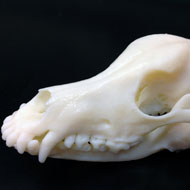
New procedure allows surgeons to regrow the full arch of the jaw
US veterinary surgeons are performing groundbreaking surgery, using 3D printing to grow new jaw bones for dogs.
Previously, vets have only been able to regrow a portion of the jaw. Now, surgeons can create the full arch of the jaw, giving the dog a more normal appearance and function.
This is thanks to a new procedure developed by Professors Frank Verstraete and Boaz Arzi at the University of California (UC) Davis School of Veterinary Medicine.
UC Davis is the only veterinary school carrying out the procedure on a routine basis.
3D printing is used to create an exact replica of the dog's skull prior to surgery. The procedure involves removing the affected portion of jaw and screwing the formed titanium plate to the bone.
A sponge soaked in bone morphogenic protein is then placed where the jaw used to be. This stimulates the remaining jaw bone to grow new bone cells. In eight to 10 weeks, the new bone is fully formed.
3D printing reduces anaesthesia time and allows surgeons to plan ahead. Previously, they would have to wait until surgery had begun before building the titanium plate.
Currently, bone regrowth protein for humans is only approved for some dental work and spinal fusion. However, Prof Verstraete says "there's a good possibility this may spill over inyo human reconstructive surgery."
The regrown jaw is slightly shorter than previously, as bone and soft tissue has to be removed and the remaining blood cells can only support so much bone regrowth. As yet, the procedure does not allow for the regrowing of teeth.
Ten-year-old collie Hoshi underwent the procedure after vets discovered squamous cell carcinoma in her mouth and the lower part of her jaw had to be amputated.
Another collie, Lad from Kentucky, was shot in the in the muzzle and had to have most of his lower jaw removed. Surgeons used data from his tomography scan to print a replica of his skull and what remains of his lower jaw. Lad's jaw was then crafted and printed.
Lad's surgery is currently on hold due to a bone infection and is hoped he will soon undergo the procedure.
Image courtesy of UC Davis School of Veterinary Medicine.



 The Greyhound Board of Great Britain has published new vaccination guidance, with all greyhounds registered from 1 January, 2027 required to have the L4 leptospirosis vaccination, rather than L2.
The Greyhound Board of Great Britain has published new vaccination guidance, with all greyhounds registered from 1 January, 2027 required to have the L4 leptospirosis vaccination, rather than L2.